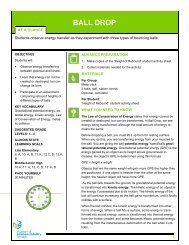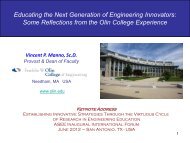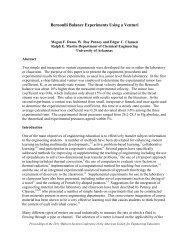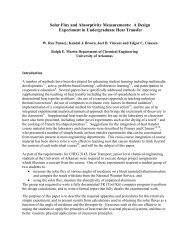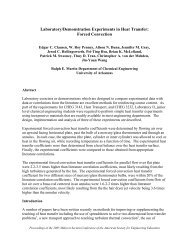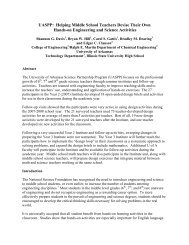Emily Ashworth - American Society for Engineering Education
Emily Ashworth - American Society for Engineering Education
Emily Ashworth - American Society for Engineering Education
Create successful ePaper yourself
Turn your PDF publications into a flip-book with our unique Google optimized e-Paper software.
United States<br />
National Science Foundation Support <strong>for</strong><br />
a Global <strong>Engineering</strong> <strong>Education</strong><br />
<strong>Emily</strong> Yaung <strong>Ashworth</strong><br />
Director, China Office<br />
U. S. National Science Foundation<br />
October 25, 2011
NSF: What Do We Do?<br />
• The only federal agency supporting basic research across all<br />
fields of science and engineering (S&E) and social sciences<br />
and at all levels of S&E education.<br />
• integrates research and education to support the<br />
development of a world‐class scientific and engineering<br />
work<strong>for</strong>ce.<br />
• funds advanced instrumentation and facilities such as Arctic<br />
and Antarctic research, science operations, and other related<br />
activities <strong>for</strong> the U.S. polar research program.<br />
• supports cooperative research between universities and<br />
industry as well as U.S. participation in international scientific<br />
ef<strong>for</strong>ts.<br />
Funds more than 50 percent of all non‐medical research in<br />
the United States at universities and other academic<br />
institutions.<br />
2
NSF by the Numbers [FY2010]<br />
$6.9 billion FY 2010 appropriations<br />
2,100 Colleges, universities and institutions receiving NSF funding<br />
55,600 Proposals evaluated through competitive merit review<br />
process<br />
13,000 Competitive awards<br />
287,000 Proposal reviews conducted<br />
294,000 (est.) Number of people NSF supports directly<br />
42,000 Students supported by NSF Graduate Research Fellowships<br />
since 1952<br />
2,100 Agency work<strong>for</strong>ce: approximately 1,400 career employees,<br />
200 scientists from research institutions on temporary duty,<br />
450 contract workers, and staff of the NSB office and Office of<br />
the Inspector General.<br />
3
Strategic Plan [2011‐2016]<br />
Vision: NSF envisions a nation that capitalizes on new concepts in science<br />
and engineering and provides global leadership in advancing research and<br />
education.<br />
Strategic goals:<br />
• Trans<strong>for</strong>m the Frontiers<br />
Emphasizes the seamless integration of research and education as well as<br />
the close coupling of research infrastructure and discovery.<br />
• Innovate <strong>for</strong> <strong>Society</strong><br />
Points to the tight linkage between NSF programs and societal need and<br />
highlights the role that new knowledge and creativity play in economic<br />
prosperity and society’s general welfare.<br />
• Per<strong>for</strong>m as a Model Organization<br />
Emphasizes the importance to NSF of attaining excellence and inclusion in<br />
all operational aspects.<br />
4
NSF‐funded Discoveries<br />
• NSF seeks high‐risk, potentially trans<strong>for</strong>mative projects that<br />
will generate path‐breaking discoveries and new<br />
technologies<br />
• In the past decades, NSF‐funded researchers have won more<br />
than 180 Nobel Prizes.<br />
• These pioneers have included scientists or teams that<br />
� discovered many of the fundamental particles of matter<br />
� analyzed cosmic microwaves left over from the earliest<br />
epoch of the universe<br />
� developed carbon‐14 dating of ancient artifacts<br />
� decoded the genetics of viruses<br />
� created an entirely new state of matter, the Bose‐Einstein<br />
condensate<br />
5
NSF on the Origin of Google<br />
6
NSF Commitment to<br />
<strong>Engineering</strong> <strong>Education</strong> (1)<br />
• Broadening Participation Research Initiation<br />
Grants in <strong>Engineering</strong> 2012 (BRIDGE)<br />
• Faculty Early Career Development Program<br />
(CAREER)<br />
• Nanotechnology Undergraduate <strong>Education</strong> in<br />
<strong>Engineering</strong> (NUE)<br />
• Research in <strong>Engineering</strong> <strong>Education</strong><br />
• Research Initiation Grants in <strong>Engineering</strong> (RIGEE)<br />
• Research Experiences <strong>for</strong> Undergraduates(REU)<br />
• Research Experiences of Teachers (RET)<br />
7
NSF Commitment to<br />
<strong>Engineering</strong> <strong>Education</strong> Research (2)<br />
Support research areas (twice a year) that address:<br />
• how engineering students learn and the capacity<br />
that supports such discovery<br />
• How to increase the diffusion and impact of<br />
engineering education research<br />
• <strong>Engineering</strong> education in broader frameworks<br />
such as sustainability<br />
• Diversifying pathways to and through engineering<br />
degree programs<br />
8
NSF Commitment to<br />
<strong>Engineering</strong> <strong>Education</strong> (3)<br />
• 17 undergraduate programs provide either<br />
direct or indirect NSF support <strong>for</strong> curricula<br />
development and training<br />
• 16 graduate programs provide either direct or<br />
indirect NSF support <strong>for</strong> educational<br />
developments<br />
• 15 postdoctoral fellows programs provide<br />
either direct or indirect NSF support<br />
9
NSF Commitment <strong>for</strong><br />
Research Experiences (4)<br />
• Research Experiences <strong>for</strong> Undergraduates<br />
(REU)<br />
• Supports the involvement of undergraduates<br />
in ongoing research; international experiences<br />
are welcome<br />
• UC San Diego, applied <strong>for</strong> a supplement to<br />
REU to send students working on earthquake<br />
research to Christchurch, New Zealand<br />
10
From Commitments to Funding Mechanisms<br />
<strong>for</strong> International Collaborations<br />
• Integral component of proposals submitted<br />
to NSF disciplinary programs<br />
• Supplements to existing awards<br />
• Proposals to International Office<br />
• U.S. participants ONLY<br />
�Faculty<br />
�Postdoctoral Researchers<br />
�Students (undergraduate and graduate)<br />
11
National Science Foundation<br />
China Office<br />
Representation‐interacts with Chinese Science<br />
and technology agencies, universities,<br />
research institutes and others.<br />
Reporting‐ Bi‐monthly highlights, topical<br />
briefs.<br />
Facilitation‐ NSF supported programs (150‐<br />
200/year) and NSF supported students (Up to<br />
500/year).<br />
12
NSF joint activities with Chinese<br />
partner agencies<br />
• National Natural Science Foundation of China<br />
• Ministry of Science and Technology<br />
• China Earthquake Administration<br />
• Chinese Academy of Sciences<br />
• Chinese Academy of Social Sciences<br />
• Ministry of <strong>Education</strong><br />
13
Sample of NSFC‐NSF Programs in<br />
Software Initiative<br />
• Joint workshops in<br />
Beijing and San Diego<br />
• Workshop organizers<br />
University of San Diego<br />
Peking University<br />
• Joint call <strong>for</strong> proposals<br />
in 2012<br />
Cyberinfrastructure<br />
14
Sample of NSF and NSFC joint Program<br />
Exploring the resilience of<br />
<strong>for</strong>ests to climate change<br />
China Team<br />
Institute of Applied Ecology (CAS)<br />
Institute of Botany (CAS)<br />
South China Botanical Garden (CAS)<br />
Xishuangbanna Tropical Botanical<br />
Garden (CAS)<br />
U.S. Team<br />
Harvard University<br />
Michigan State University<br />
Smithsonian National Museum of<br />
Natural History<br />
Smithsonian Tropical Research<br />
in Biodiversity<br />
15
NSF Supported Programs in China<br />
• Programs Supporting Research Infrastructure<br />
GLORIAD [CNIC/CAS]and CERNet [Tsinghua U.]<br />
• Programs Addressing Global Challenges<br />
Integrated Ocean Drilling, Earthquake Studies,<br />
Network of Earthquake <strong>Engineering</strong> Simulation<br />
(NEES)<br />
• Programs Supported by the Directorates<br />
Biodiversity, Software initiative, biosensors, ICC<br />
Chemistry network, Material Sciences Network<br />
• Programs Supported by the Office of International<br />
Science and <strong>Engineering</strong><br />
16
CERNet-TransPac<br />
10G Icelink (Southern)<br />
Alexandria<br />
Mumbai<br />
Singapore<br />
Credit: Natasha Bulashova, GLORIAD-US<br />
18
Basic Research to Enable Agricultural<br />
Development (BREAD)<br />
NSF program funded jointly by NSF and the Bill & Melinda<br />
Gates Foundation (BMGF)<br />
• $48 million over 5 years, equally supported by NSF and<br />
BMGF, with the potential to be extended<br />
• Brings together the BMGF track record in agricultural<br />
development and NSF’s peer‐reviewed marketplace <strong>for</strong><br />
new ideas<br />
• Focus is on innovative basic research in any area that could<br />
benefit smallholder farmers. No target countries<br />
19
Wuhan Botanical Garden Participated in a global<br />
study of disease resistant wheat (BREAD)<br />
• A study of genetic and food<br />
supply processes, involving China,<br />
U. S., Australia, and Kenya. Also<br />
supported by Bill & Melinda<br />
Gates Foundation.<br />
• Will provide new and useful<br />
sources of rust resistant crops to<br />
developing countries.<br />
• Will offer exchanges <strong>for</strong> young<br />
scientists to learn new<br />
technologies and educate small<br />
farmers.<br />
20
Programs supported by the Office of<br />
International Science and <strong>Engineering</strong><br />
• Catalyzing New International Collaborations (CNIC)<br />
• Partnerships <strong>for</strong> International Research and<br />
<strong>Education</strong> (PIRE)<br />
• International Research Experiences <strong>for</strong> Students<br />
(IREU)<br />
• East Asia& Pacific Summer Institute (EAPSI)<br />
• International Research Fellowship Programs (IRFP)<br />
• Advanced Studies Institutes (ASI)<br />
21
Partnerships <strong>for</strong> International<br />
Research and <strong>Education</strong> (PIRE)<br />
Of the 46 awards, 10 involved China<br />
• UCSB: electron chemistry and catalysis<br />
($2.5M+$4M)<br />
• Michigan: training in social context,<br />
population, and environmental change<br />
($2.5M)<br />
• Nevada: hot spring ecosystems ($3.8M)<br />
• Missouri: earthquake ($2.2M)<br />
• Northwestern: intelligent structural health<br />
management ($2.5M)<br />
• Georgia: invasive species ($2.5M)<br />
• FIU: cyber infrastructure ($2.3M)<br />
• Columbia: superconductivity ($2M)<br />
• Illinois at Chicago: data cloud ($3.5M)<br />
• Penn State: bilingualism, mind, and brain<br />
($2.8M)<br />
22
PIRE: Hot Springs Research in Tengchong<br />
Location:<br />
Western Yunnan Province in SW<br />
China, near Myanmar<br />
Geological setting:<br />
• Latent heat associated with<br />
Miocene/Pleistocene volcanism<br />
derived from Eurasian‐Indian Plate<br />
collision<br />
Geochemistry:<br />
• Dominant Na‐HCO 3 or Na‐Cl‐HCO 3<br />
(andesite basalt host)<br />
• Reservoir temps ~150°C, slow<br />
discharge<br />
cene/Pleistocene volcanism derived<br />
from Eurasian‐Indian Plate collision<br />
Geochemistry:<br />
• Dominant Na‐HCO 3 or Na‐Cl‐<br />
HCO 3 (andesite basalt host)<br />
• Reservoir temps ~150°C, slow<br />
discharge<br />
23
John Peters, N,<br />
C, H cycling;<br />
community<br />
function; MSU<br />
integration<br />
Jose de la Torre,<br />
N cycle;<br />
cultivation &<br />
genomics<br />
Steve Quake,<br />
Single‐cell<br />
genomics<br />
PIRE:Tengchong‐U.S.Partners<br />
Chris Ross,<br />
Bioin<strong>for</strong>matics;<br />
programming;<br />
metagenomics<br />
SFSU<br />
Stan<strong>for</strong>d<br />
MSU<br />
UNLV<br />
NAU<br />
ASU<br />
Brian Hedlund,<br />
Single‐cell<br />
genomics; data<br />
integration<br />
Kurt Regner,<br />
Undergraduate<br />
coordinator<br />
Miami<br />
UGA<br />
Bruce Hungate, N,<br />
C cycling;<br />
community<br />
ecology<br />
Mary Kay Orgill,<br />
High‐school<br />
teacher<br />
participation<br />
Hailaing Dong,<br />
Geobiology;<br />
community<br />
function<br />
Chuanlun Zhang,<br />
Organic<br />
geochemistry;<br />
lipid biomarkers<br />
Hilairy Hartnett,<br />
C, N cycling; ASU<br />
integration<br />
24
PIRE:Tengchong‐ Chinese partners<br />
Wen‐Jun Li,<br />
Microbial<br />
cultivation,<br />
taxonomy<br />
Nianzhi Jiao, C<br />
cycle, single‐cell<br />
genomics<br />
Shucheng Xie,<br />
Paleobiology<br />
Yunnan<br />
Yangxin Wang,<br />
Hydro‐<br />
geochemistry; As<br />
cycling<br />
CAS<br />
CUGB<br />
CUGW<br />
Tongji<br />
Xiamen<br />
Li Li, Organic<br />
geochemistry<br />
Li Huang,<br />
Genomics,<br />
metagenomics,<br />
cultivation<br />
Hongchen Jiang,<br />
Functional<br />
genomics<br />
Huaiyang Zhou,<br />
Hydrogeology,<br />
geochemistry<br />
25
PIRE: Electron Chemistry and Catalysis at Interfaces (ECCI)<br />
<strong>for</strong> sustainable energy applications<br />
电子化学和表面催化领域研究 ‐‐ 国际研究和教育合作团队<br />
China<br />
Dalian Institute <strong>for</strong> Chemical Physics,<br />
CAS<br />
Tsinghua University<br />
Institute of Chemistry, CAS<br />
Institute <strong>for</strong> Nanotech & Nanobionics<br />
(SINANO)<br />
University of Science and Technology of<br />
China<br />
U.S.<br />
University of Cali<strong>for</strong>nia‐Santa Barbara<br />
26
PIRE: U.S.‐Asia Network of Centers <strong>for</strong><br />
Intelligent Structural Health Management of<br />
Safety‐Critical Structures<br />
China<br />
Dalian University of Technology<br />
Harbin Institute of Technology<br />
U.S.<br />
Northwestern University (lead institution)<br />
University of Illinois, Chicago<br />
Collaborators:<br />
• Indian Institute of Technology, Madras<br />
• National Aerospace Labs, India<br />
• Pusan National University, South Korea<br />
• GE India Technology Center<br />
• Goodrich Corporation<br />
• Honeywell<br />
• Boeing<br />
Harbin<br />
27
Research Experiences <strong>for</strong> Students (IREU)<br />
Four programs in China<br />
• Advanced Materials : Clarkson<br />
Univ./ Tsinghua Univ., Nanjing<br />
Univ./and CAS<br />
• Chemistry/Chemical Eng: U.C.<br />
SB/Dalian Univ. of Technology<br />
and Dalian Institute of Chemical<br />
Physics, CAS<br />
• Aerodynamics: Shanghai<br />
Jiaotong/Iowa State<br />
• Behavior of primates: Central<br />
Washington Univ./Anhui<br />
Normal Univ.<br />
28
East Asia and Pacific Summer Institute <strong>for</strong><br />
U. S. Graduate Students<br />
• Joint program with Ministry of<br />
Science and Technology<br />
• Each year, up to 40 graduate<br />
students will conduct research<br />
<strong>for</strong> two months in China<br />
29
Samples of <strong>Engineering</strong> <strong>Education</strong><br />
Program in China (1)<br />
The Studies of Dye‐Sensitized Solar Cells<br />
• Tsinghua Univ. and Univ. of Pittsburgh<br />
• Train graduate and undergraduate students<br />
with international field study module, and<br />
outreach to underrepresented pre‐college<br />
students‐workshops in Pittsburgh high schools<br />
30
Sample of <strong>Engineering</strong> <strong>Education</strong><br />
Project in China (2)<br />
Materials and system biology research in<br />
biotechnology and biomedicine<br />
• Texas A&M Univ. and Tsinghua Univ.<br />
• Train undergraduate students to use<br />
chemical engineering approach to<br />
material<br />
• Create a model program <strong>for</strong> diverse<br />
population including linkage with<br />
students in in Bogota, Columbia<br />
31
Sample of <strong>Engineering</strong> <strong>Education</strong><br />
Project in China (3)<br />
Advanced Materials <strong>for</strong> a Sustainable<br />
Development (IREU)<br />
• Clarkson Univ., Tsinghua Univ., and CAS Institute<br />
of Physics<br />
• Undergraduate students work with materials<br />
researchers to explore methods <strong>for</strong> designing<br />
and fabricating materials<br />
• Receive support from Corning research in China<br />
32
Sample of <strong>Engineering</strong> <strong>Education</strong><br />
Programs in China (4)<br />
International Materials Institute <strong>for</strong><br />
Solar Energy Conversion<br />
• Northwestern Univ., Louisiana State Univ., Argonne<br />
National Lab, and Tsinghua Univ.<br />
• Will include 35 institutions worldwide<br />
• Focus on OPVC to understand physical processes and<br />
limitations to efficient conversion and storage of solar<br />
energy<br />
• Have educational focus to develop courses on energy<br />
conversion, teaching modules on solar energy <strong>for</strong> K‐12<br />
schools, and outreach to the public on solar energy.<br />
33
How to Increase Global <strong>Engineering</strong><br />
<strong>Education</strong> Opportunities<br />
• Understand NSF and other funding<br />
mechanisms and opportunities<br />
• Learn about the bilateral programs between<br />
NSF and host country S&T agencies<br />
• Build on your strengths and find compatible<br />
institutional partners in host country<br />
• A good partnership requires courtship,<br />
patience, and trust<br />
34
Contact In<strong>for</strong>mation<br />
<strong>Emily</strong> Yaung <strong>Ashworth</strong>, Ph.D. 杨容珍博士<br />
Director, China Office<br />
U. S. National Science Foundation<br />
Embassy of the United States of America<br />
Room 1816, Silver Tower,<br />
No.2 Dongsanhuanbeilu<br />
Chaoyang District, Beijing, China 100027<br />
Tel: (86‐10) 6410‐6931/32‐103<br />
Email: eashwort@nsf.gov<br />
Website: www.nsfbeijing.cn<br />
35
Thank You!<br />
谢谢! 36



